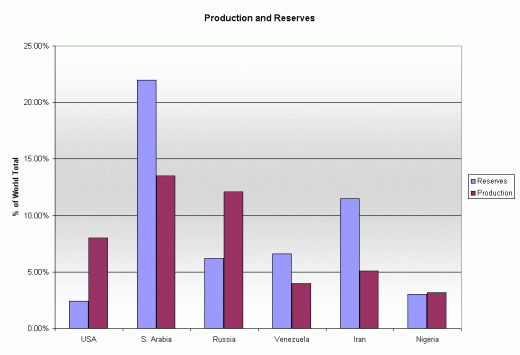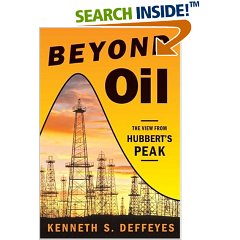Crude Oil Production Means Investment - Iran and Venezuela are Failing to Invest
Commodities / Analysis & Strategy Feb 08, 2007 - 12:05 AM GMTBy: Elliot_H_Gue
 Here's a challenge for you: Name the top three largest oil-producing countries in the world.
Here's a challenge for you: Name the top three largest oil-producing countries in the world.
If you're like most investors, you probably know that the world's largest oil producer is Saudi Arabia. In 2005, Saudi Arabia churned out more than 11 million barrels of oil per day, roughly 13.5 percent of the world's total supply.
And you may have guessed the world's second-largest producer: the Russian Federation. In 2005, Russia chipped in about 9.5 million barrels per day, a bit more than 12 percent of the total global production.
But guessing the world's third-largest producer is more of a challenge. If you guessed Nigeria, Venezuela, Iraq, Iran, the United Kingdom or Canada, you're incorrect. The third-largest oil producer in the world is the US. The US produced 6.8 million barrels of oil per day in 2005, edging out Iran by more than 2.75 million barrels per day.
To put that into perspective, US oil production in 2005 was roughly equivalent to production from all of South and Central America combined. US oil production was also more than double that of Venezuela. At first blush, this seems almost incomprehensible. But consider my chart below.

Source: BP Statistical Review of World Energy 2006
This chart depicts two bars for each country. The first bar is each country's percentage of global oil reserves. The second bar represents the country's share of world oil production (in percentage terms).
The most-striking feature of this chart is the data for the US. While the US only has a little less than 2.5 percent of the world's known reserves, it produces some 8 percent of the world's oil. The US produces more oil than Venezuela, Iran and Nigeria but has smaller reserves than any of these three countries. Note in particular just how low oil production is for Iran and Venezuela compared to their reserve base.
While seemingly incongruous, there's a logical explanation for that situation: US oil reserves are the most developed of any country in the world. More wells have been drilled in the US than in any other country in the world. And the US is a leading market for enhanced oil recovery techniques, including carbon dioxide floods and pumps. In other words, a tremendous amount of investment has poured into developing US oil reserves during the past century and a half.
Investment is the key concept. Earlier this week, a report from the National Academy of Sciences concerning Iran attracted considerable attention. The report's primary author is Roger Stern from Johns Hopkins University; Stern estimates that Iranian oil production is declining an around 10 to 12 percent annually. As this rate, Iran will no longer be able to export oil by around 2015.
The problem isn't that Iran is running out of oil; the nation has the world's second-largest oil reserves behind Saudi Arabia. In fact, the concept of "running out" of oil is bogus for any country. The question isn't how much oil is in the ground but how much a country produces in a given year and how quickly production can ramp up. The term "peak" oil refers to peak production, which occurs long before a country depletes its reserves.
The real culprit to Iran's declining oil production is a lack of investment--the country isn't reinvesting enough of its oil revenues into existing infrastructure repairs and upgrades or in developing reserves. In fact, while the report was enlightening, much of this has been known for some time.
Specifically, instead of reinvesting oil revenues to maintain production, Iran has systematically pursued some self-destructive policies. The country heavily subsidizes oil domestically; the current cost of a gallon of gasoline in Iran is 35 cents. As with any subsidized commodity, consumers have little incentive to conserve when prices are so low; a good deal of oil is likely wasted in Iran.
In addition, the Iranian government, led by President Mahmoud Ahmadi-Nejad, has followed a vaguely socialist policy with respect to oil revenues. In fact, during his election campaign, Ahmadi-Nejad claimed that he intended to "put the fruits of oil wealth on the ordinary person's dinner table."
The practical implementation of this policy has been to dump most of the country's oil revenues into all sorts of domestic aid, credit support and housing programs. Public spending shot higher to $213 billion in 2006, up 21 percent year-over-year. Oil revenues account for about 65 percent of Iran's government revenues. Given that less than $4 billion gets reinvested in oil infrastructure every year, Iran's failing oil production picture should come as little surprise.
To make matters worse for the domestic oil industry, banks and foreign investors aren't lending and investing in Iran as freely as before, given the controversies surrounding its nuclear program. Iran's oil minister recently acknowledged this fact in a public statement. Without massive investments and foreign cooperation, Iran's oil production is likely to drop during the next decade, even though the country has some of the world's largest and most-attractive reserves.
And it's not just Iran. Other countries suffer from the same lack of investment due to destructive domestic policies. Take, for example, Venezuela.
 |
The US certainly has imposed no sanctions on Venezuelan oil and remains that nation's largest customer. In addition, Venezuela has some of the most-attractive untapped oil reserves in the world, including heavy oil potential in the Orinoco Belt. Certainly, Venezuelan oil reserves look far more attractive than any onshore or shallow-water US plays. Yet, Venezuela's oil production stands some 200,000-plus barrels per day under where it was in 2000.
The problem is that Venezuelan oil reserves take a particularly large amount of capital to produce. Heavy oil projects, in particular, are capital intensive. Unfortunately, President Hugo Chavez has been somewhat uncooperative with foreign oil companies, a move that's limited their willingness to invest there.
And the country's national oil company Petroleos de Venezuela (PDVSA) has systematically been forced to spend extravagant amounts of money on domestic social programs, cutting its ability to reinvest in production. In an even stranger twist, Venezuela has been providing subsidized heating oil to poorer American families.
While that may seem a kind and generous policy, it isn't. All this spending and subsidization has a hidden cost--robbing the potential for future production growth. Inevitably, we'll all pay for the reduced supply of oil from Venezuela because it will eventually mean higher prices for everyone. But Venezuela will bear the highest costs of all.
Bottom line: The true Iranian and Venezuelan shocks to the global oil market may not be these countries using oil as a weapon but rather expansive domestic social policies that prevent reinvestment in the industry.
By Elliott H. Gue
Elliott H. Gue is editor of The Energy Letter , a bi-weekly e-letter as well as editor of The Energy Strategist , a premium bi-weekly newsletter on the energy markets. Mr. Gue is also associate editor for Personal Finance , where he contributes his knowledge of the energy markets.
Mr. Gue has a Master's of Finance degree from the University of London and a Bachelor of Science degree in Economics and Management from the University of London , graduating in the top 3 percent of his class. Mr. Gue was the first American student to ever complete a full degree at that university
© 2005-2022 http://www.MarketOracle.co.uk - The Market Oracle is a FREE Daily Financial Markets Analysis & Forecasting online publication.


